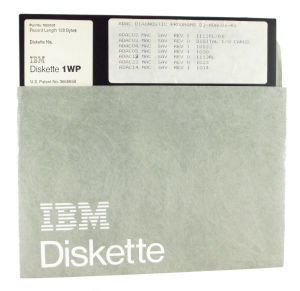
|
This site is running on a 286 PC, booted and served
entirely from a 90mm floppy disk. See current
server stats. All content on this site is provided by the Museum of Obsolete Media, curated by Jason Curtis. My sincerest thanks to Jason for providing me with the worthy challenge of exhibiting his work in the only appropriate way: The Floppy Disk Museum: The Bootable Floppy edition! |


The 8 inch floppy disk (or diskette) was a magnetic storage disk for data that was introduced commercially by IBM in 1971.
It was designed by a team led by David L. Noble in IBM as an inexpensive way to load data into the IBM System/370, and was initially simply a read-only bare disk (the 'Memory Disk') holding 80 KB of data, or the equivalent of 3,000 punched cards.
By the time of it's commercial launch, it had been enclosed in a 203.0 mm x 203.0 mm x 1.6 mm plastic envelope lined with fabric, to protect the disk and minimise the problems caused by dust.
The first read-write version was introduced in 1972 by Memorex, and could hold 175 KB on 50 tracks (with 8 sectors per track). It was hard-sectored and had 8 sector holes (and an index hole) on the outer diameter.
Further improvements led to teflon-lubricated fabric liners, teflon-coated disks and an eventual increase in capacity to 1.2 MB in the double-sided double density (DSDD) version in 1977.
It was eventually displaced by the 5.25-inch floppy disk ((initially called the minifloppy to avoid confusion between the two sizes) developed in 1976 by Shugart Associates, a company founded by Alan F. Shugart who previously worked at IBM on the development of the 8-inch floppy.
The 8-inch floppy disk is briefly seen in the 1983 film War Games, along with an acoustic coupler.